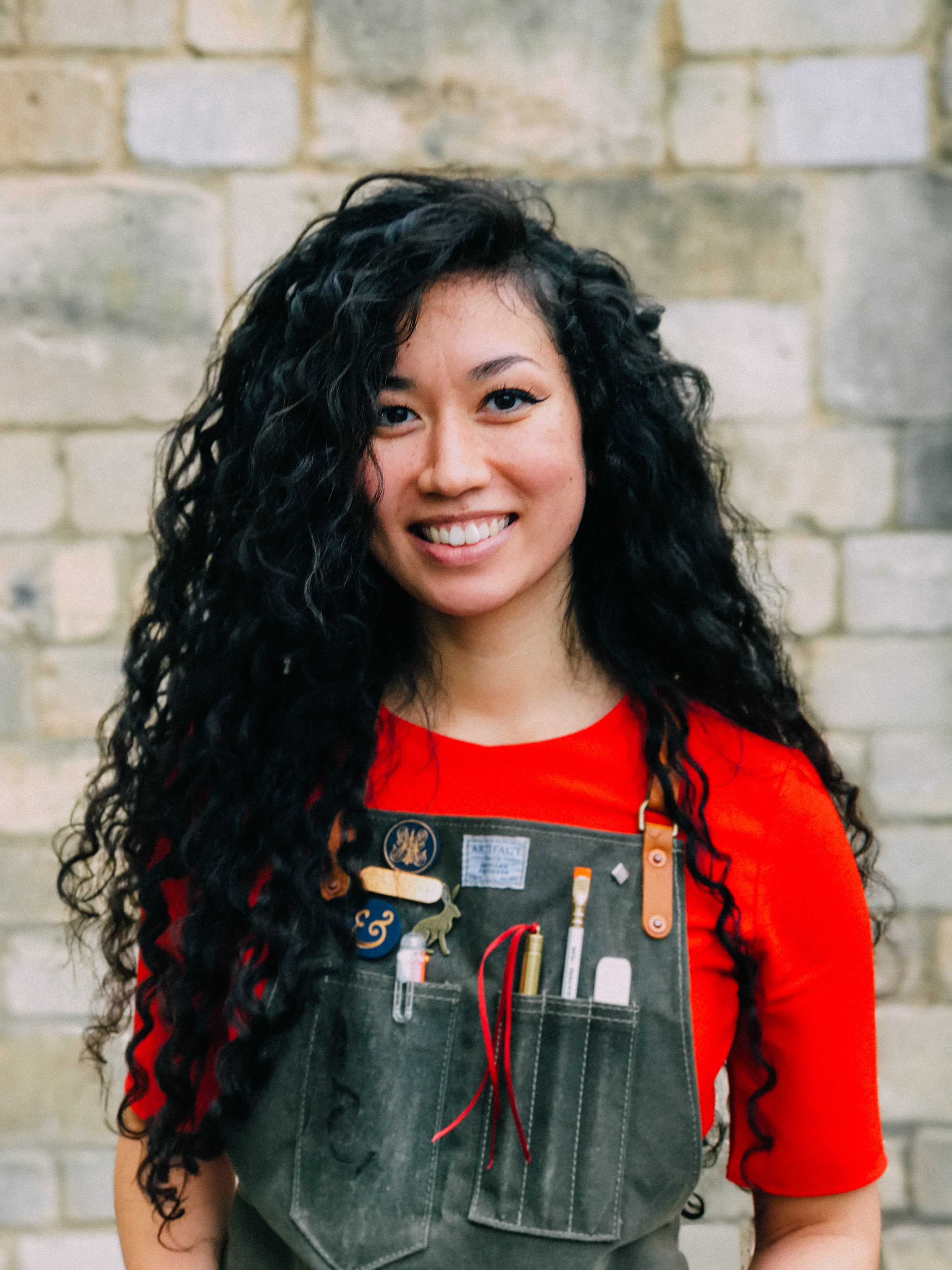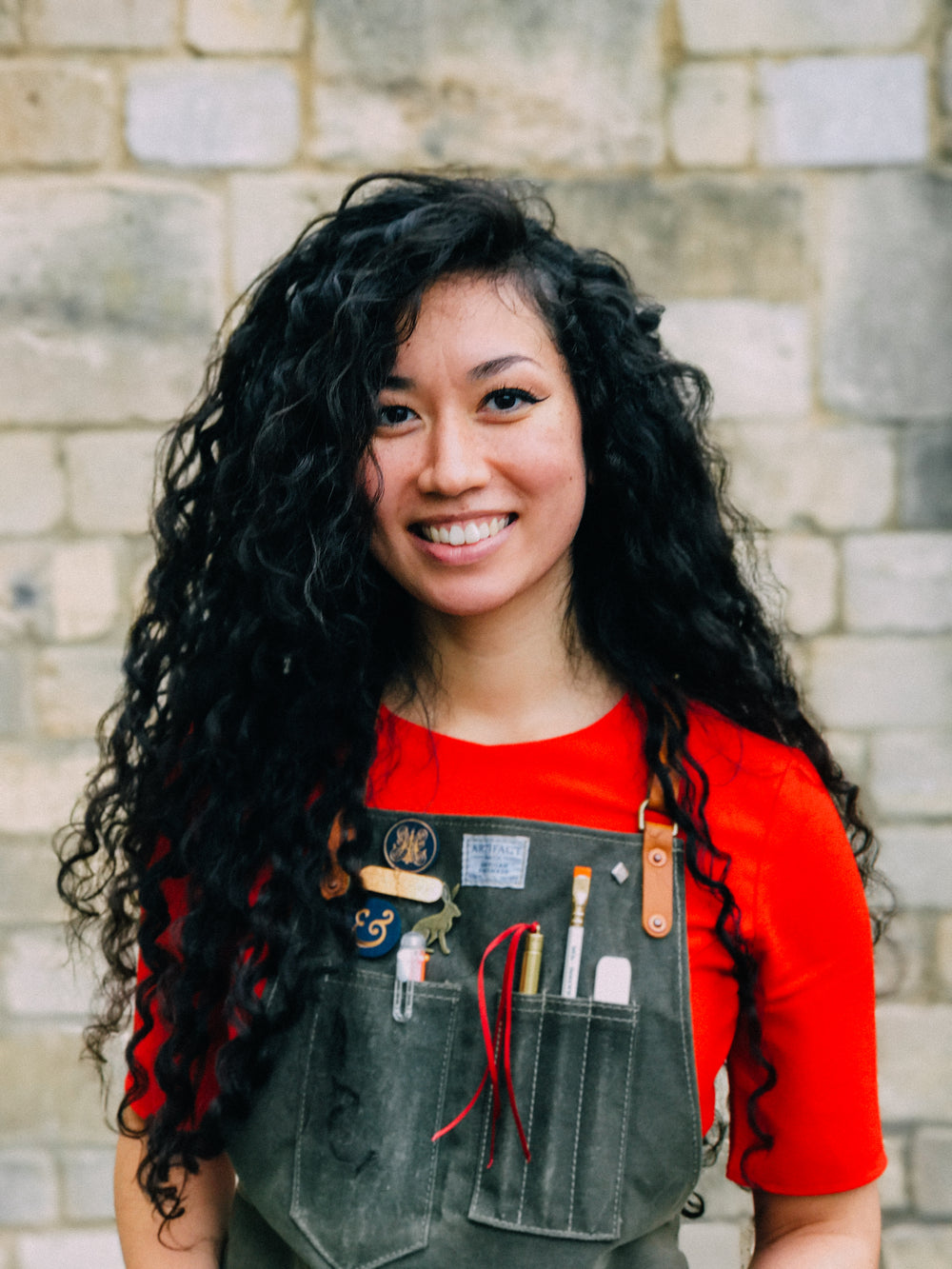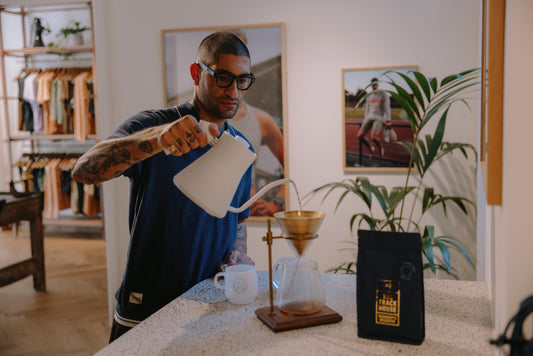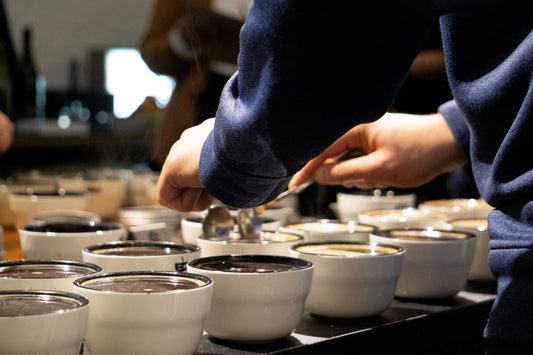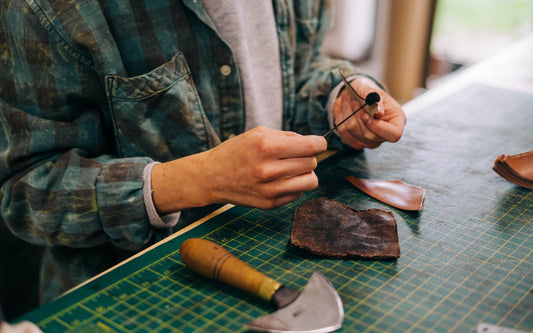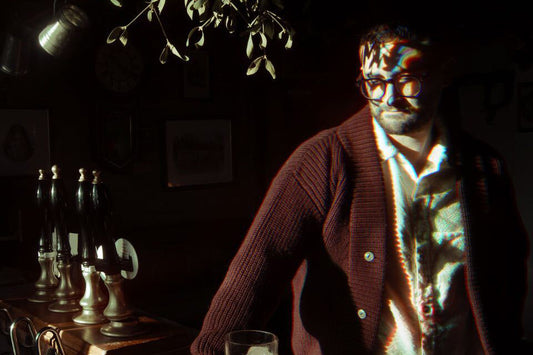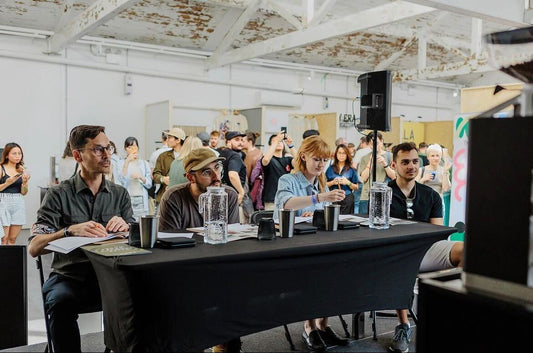
Our ‘Love Your Work’ profile series sets out to discover and showcase individuals, organisations and initiatives, all of whom share our commitment to quality.
For the second piece in the series, we travelled to Bath, Somerset, to chat with Athena Cauley-Yu, owner of Meticulous Ink – a fine stationery and letterpress printing company.
Who are you and what do you do?
I’m Athena and I run Meticulous Ink - a fine stationery and letterpress printing company located on Walcot St in the centre of Bath.
We do quite a few different things. Firstly, we have the retail stationery side of our business, so we sell our own brand of stationery and paper goods, as well as a curated selection of our favourite stationery things like calligraphy pens, inks etc. We’re also stocked at a number of London department stores - Harrods, Fortnum & Masons, Liberty – and then we offer a bespoke printing service, which is the main part of our business. Our bespoke projects range from business cards, to personal stationery, to wedding invitations. Oh, and I also run calligraphy workshops in Bath and the surrounding area!

How did you get into fine stationery and letterpress printing?
When I finished school, I went straight to university and did Arts & Media. It was a great course if you didn’t really know what you wanted to do because you basically just got put in other peoples’ classes and got to try a whole range of things. In my final year I decided to specialise in Fine Art Printing almost solely because hardly anyone used the print studio – it was empty. There were seventy of us crammed in the art studio, but only about four of us in that print studio.
After university, I did six months of door-to-door charity fundraising (which was really tough) and then I got a job with a stationery company in London’s Sloane Square. I worked there for two years before being poached by another private stationery company in nearby Mayfair. I always knew I wanted to run my own business and my partner at the time wanted to leave London, so I thought this could be a good time to do it. It took me six months to put together the business plan, find a shop and get together enough money (thanks to a business loan, three credit cards and all my life savings!) before opening my first shop in 2010, just down the street from where we are now.
When we first opened, we didn’t do the actual printing in-house - we would do all the design but would then outsource the printing to the shop in London where I used to work. This was fine for a bit, but I realised pretty quickly that I was a lot more meticulous than they were and I just wasn’t happy with the quality or consistency of the printing.
My original business plan had us buying our first big printing press at the three year mark, but I quickly realised that I wanted to be in control of every step of the printing process and so it actually ended up happening after three months. It was a shame to end the relationship with my previous employer, but I soon realised the more we could do ourselves in-house, the better. That way we could have complete control over each stage of production.
That first printing press we bought was initially based in Dorset, which wasn’t ideal and involved a fair amount of travel to oversee production runs. So as soon as we found ourselves a bigger shop [where Meticulous Ink now resides], we moved everything in here.
It’s great to have the machines here because we can show people how the print process works and do quick demonstrations. It just makes a lot more sense to have everything the business does in one building, even if people still come in and ask if we actually use them!

What is it you love so much about letterpress printing?
Without a doubt, it’s the texture. There’s simply no other way you can achieve that in printing. It makes a flat thing 3D, and I love that.
The machines are amazing too. You can tweak absolutely everything about them and, despite their large, lumbering appearance, they’re incredibly precise. For example, you can tweak the speed at which it picks up paper, the thickness of the sheet of paper, the amount of impression the machines gives, the speed of the printing, the amount of ink that goes on the press. Creating something that’s really, really delicate, out of such an old and massive machine is extremely satisfying.

How many of you are here at Meticulous Ink?
There are five of us in total - three full-time and two part-time. We’re a small company so everyone does a bit of everything, but Julia does the majority of our printing, and then the other roles include quality checking, print finishing and packing, client contact, and shipping the online orders.
Do you have plans to open more spaces in the future?
People always ask me if we’re going to open another branch and I definitely don’t feel ready to do that. Because of wanting to keep the quality so high, and wanting to be in control of everything, it doesn’t really make sense to me.
I feel like there’s still a lot we can do here, which isn’t 100% perfect yet, and I’d want to do that first. We can definitely continue growing our online presence, and we’ve got these cool new kits we’re releasing for Christmas which will hopefully help with that. I always try and keep in mind where the business might move next, but as any small business owners knows, it’s very hard to think long-term when you’re trying to keep the everyday stuff ticking along. I recently did a business strategy workshop supported by Bath Council and that was really useful in making me think more long term.
Where did the name Meticulous Ink come from?
It took ages to come up with the name and it was only really after we opened that we realised that from then on, everything we did had to be meticulous and absolutely perfect. So, in order to live up to the name, we quality check (QC) everything that leaves the shop to the highest standard. The greetings cards on the shelves, for example - we’ll check if the board has fluff on it, if it’s slightly over or under inked, if the pressure is slightly different or if there’s a slight tear in the tissue lining. We check all of that. One of the team might be QC’ing and will ask another member of the team “Do you think this is okay”, and the rule of thumb tends to be that if you have to ask, it’s probably not.
This high standard means that we end up with a lot of items which we decide not to sell. The problem is, I’m quite the hoarder and really don’t like throwing things away, so these items end up in various ‘dud’ piles. We have a ‘really dud’ pile, a ‘medium dud’ pile, and then a ‘good dud’ pile, so very occasionally we’ll do a sample sale. It’s a good way to clear out stuff which, to the untrained eye, looks great, but that we’re not 100% happy with.

You’re clearly committed to providing a product of an incredibly high standard, but what does quality mean to you?
For us, quality is something that runs through every stage of the process. For example, if we’re printing one of our own branded products, we’ll be making sure that the initial design process is as cleaned-up and perfect as possible, printing out every stage and making sure it’s all as it should be, and then checking with each other that it’s good enough.
Then, onto the printing stage, we have to make sure the plates are perfect. The plates are the one thing we don’t create ourselves. It took us a while, but we eventually found a company who have just as high standards as we do and their plates are fantastic. Whilst the piece is being printed, we’ll try to filter out any major ‘duds’ straight away and continuously check that the ink quality and texture are consistent.
After that, everything is cut down on our 1990s guillotine, so we make sure the crop marks and the scoring are all perfect. Finally, we do the actual QC checks before packing the item up. So for me, quality is about respecting every single stage of a process.

How exacting can your bespoke clients be?
The majority of the time, people are very picky, and they don’t really realise it until they get into this process. My favourite bespoke projects have always been with people who have a vague idea of what they want, but maybe aren’t creative themselves and therefore they’re happy for us to take the lead. At the other end of the spectrum are the people who have a very specific idea of what they want in their head, but struggle to translate it into words. The challenge for me is to draw what they really mean out of them, and that’s why an initial consultation is so important and why I like meeting people – you can get so much more from being face to face with someone. Wedding invites can be particularly tricky, because there are two people making the decision, but equally it’s usually really fun doing those.

Where do you look for inspiration?
I must admit, I don’t really. Or at least, not that often. If I was doing a logo design for a client then I might do some research on a certain theme, in a Dover Book for example, but I actually try not to look at other people’s work all that much. In a way, it’s because I don’t want to be trendy, I just want to do our thing and do it well.
You mentioned ‘our thing’, do you feel you have a style that’s unique to Meticulous Ink?
I’d like to think so! In terms of our design, because we design specifically for letterpress printing, there are certain restrictions we have to adhere to. Say we’re doing a greeting card, for example, then we know that it can’t have loads of solid areas mixed with loads of thin areas, but then you can do lots of cross-hatching. In a similar way, the number of colours you use means using more plates, and so that makes you layer colours more instead. It’s those limitations, because of the print methods we’re using, that affect the artwork and that, in turn, gives us ‘our look’.

Have you ever had a mentor, or is there someone who has been particularly influential in the development of your work so far?
The letterpress world is extremely friendly because everyone who does it just wants it to keep going and to survive as a medium. So when we first opened, we were befriended by quite a few, what we call, ‘old man printers’ - men in their sixties plus who just love letterpress and wanted to help. There was a gentleman called Simon Smallwood, a hobbyist printer, but a complete expert, whose basement was completely packed with letterpress equipment. He helped us train on our first letterpress machine, a clanky old thing from the 1870s, and then another chap called Richard Lawrence, who now works in Oxford, who helped train us on the bigger machines we have now.
Over the years I’ve befriended quite a few other small business owners which has been really helpful. There’s Carmen, who owns A Yarn Story a few doors down from us - she’s amazing and has a really good business head, and Kate, who owns The Makery. They’ve both been really good to me and for me. So in terms of letterpress and the business side of things, I’ve had a lot of help from some very generous people, but when it comes to design, I prefer to do my own thing.
What do you do to relax?
I’m a Lindy Hop Swing dancer, which is 1920s-50s partner dancing, it’s so fun. Last night I was dancing in Bristol where there’s a big swing dance scene and lots of live music. Pretty much every week there’s some sort of event in Bristol and I go to classes in Bath. My teachers - Graeme & Ann of Hoppin’ Mad - are in their 60s and they’re just so fit and such amazing dancers, and they run four or five social dances a year. I also like knitting and sewing, and generally making with my hands. I think the dancing is so good for me, as it’s really physical and the complete opposite of what I do day-to-day
Share:

